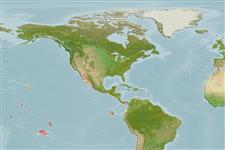Classification / Names
Common names | Synonyms | Catalog of Fishes(genus, species) | ITIS | CoL | WoRMS | Cloffa
Teleostei (teleosts) >
Blenniiformes (Blennies) >
Dactyloscopidae (Sand stargazers)
Etymology: Myxodagnus: Greek, myxos = mucus + Greek, agnos = pure (Ref. 45335); walkeri: Named after Boyd W. Walker in recognition of his fieldwork which produced much of the present material and many other eastern Pacific dactyloscopids (Ref. 39697).
Environment: milieu / climate zone / depth range / distribution range
Ecology
Marine; demersal; depth range 0 - 6 m (Ref. 39697). Tropical
Distribution
Countries | FAO areas | Ecosystems | Occurrences | Point map | Introductions | Faunafri
Eastern Central Pacific: Nayarit, Mexico and Golfo de Nicoya, Costa Rica.
Size / Weight / Age
Maturity: Lm ? range ? - ? cm
Max length : 5.5 cm SL male/unsexed; (Ref. 39697)
Short description
Identification keys | Morphology | Morphometrics
Dorsal spines (total): 8 - 10; Dorsal soft rays (total): 28 - 31; Anal soft rays: 33 - 38. Preorbital length longer than diameter of pigmented eye; upper lip fimbriae usually 10-11; modally 2 pores in 1st preopercular canal; dorsum of head mainly speckled with small brown spots, without large blotches or spots; without a distinct suborbital bar or prominent blotches on lower jaw (Ref. 39697).
Life cycle and mating behavior
Maturities | Reproduction | Spawnings | Egg(s) | Fecundities | Larvae
Dawson, C.E., 1976. Studies on eastern Pacific sand stargazers 3. Dactylagnus and Myxodagnus, with description of a new species and subspecies. Copeia 1976(1):13-43. (Ref. 39697)
IUCN Red List Status (Ref. 130435)
Threat to humans
Harmless
Human uses
Tools
Special reports
Download XML
Internet sources
Estimates based on models
Phylogenetic diversity index (Ref.
82804): PD
50 = 0.5312 [Uniqueness, from 0.5 = low to 2.0 = high].
Bayesian length-weight: a=0.01000 (0.00244 - 0.04107), b=3.04 (2.81 - 3.27), in cm total length, based on all LWR estimates for this body shape (Ref.
93245).
Trophic level (Ref.
69278): 4.3 ±0.6 se; based on size and trophs of closest relatives
Fishing Vulnerability (Ref.
59153): Low vulnerability (10 of 100).
